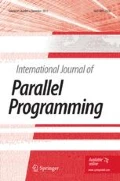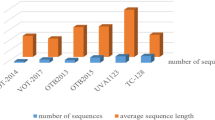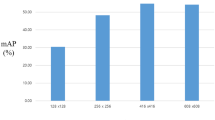Abstract
In order to improve the computational speed and detection accuracy of the ViBe algorithm in foreground edge detection, an improved algorithm based on ViBe moving objects edge detection is proposed in this study by using the partial neighborhood model H(x, y) of a pixel at the point (x, y) to find the absolute difference between H(x, y) and the pixel’s original background model M(x, y) to determine if the pixel is moving. According to the nature of the algorithm, a method based on offset thread block coordinates to optimize thread divergence is proposed from the perspective of calculation level of kernel function and a CUDA (computing unified device architecture) based method is propsed to optimize the stream transmission between CPU and GPU in order to the run time efficiency of the new algorithm. The experimental results indicated the improved algorithm implements ghost elimination, avoids large-area irrelevant background edges and achieves better efficiency and accuracy.







Similar content being viewed by others
References
Jeon, G., Anisetti, M., Lee, J., et al.: Concept of linguistic variable-based fuzzy ensemble approach: application to interlaced HDTV sequences. IEEE Trans. Fuzzy Syst. 17(6), 1245–1258 (2009)
Wu, J., Anisetti, M., Wei, W., et al.: Bayer demosaicking with polynomial interpolation. IEEE Trans. Image Process. 25(11), 5369–5382 (2016)
Wang, J., Wu, J., Wu, Z., et al.: Bayesian method application for color demosaicking. Opt. Eng. 57(5), 1 (2018)
Jeon, G., Anisetti, M., Damiani, E., et al.: Locally estimated heterogeneity property and its fuzzy filter application for deinterlacing. Inf. Sci. 354(C), 112–130 (2016)
Shi, J., Wu, J., Anisetti, M., et al.: An interval type-2 fuzzy active contour model for auroral oval segmentation. Soft. Comput. 21(9), 1–21 (2015)
Qian, Y., Jeon, G.: Weight assignment using entropy. Int. J. Multimed. Ubiquitous Eng. 11(1), 353–362 (2016)
Qian, Y., Wang, J., Jeon, G., et al.: Image deinterlacing using region-based back propagation artificial neural network. Opt. Eng. 52(6), 3294–3298 (2013)
Xie, H., Yuan, B., Xie, W.: Moving target detection algorithm based on the improved three-frame differences and ViBe algorithm. Appl. Sci. Technol. 43(6), 46–52 (2016)
Min, W.D., Guo, X.G., Han, Q.: An improved ViBe algorithm and its application in traffic video processing. Guangxue Jingmi Gongcheng/Opt. Precis. Eng. 25(3), 806–811 (2017)
Dewes, P., Frellesen, C., Albutmeh, F., et al.: Comparative evaluation of non-contrast CAIPIRINHA-VIBE 3T-MRI and multidetector CT for detection of pulmonary nodules: in vivo evaluation of diagnostic accuracy and image quality. Eur. J. Radiol. 85(1), 193–198 (2016)
Zhang, H.B., Huang, S.: Comprehensive dynamic background updating method for real-time traffic visual surveillance. J. Comput. Appl. 27(9), 2134–2136 (2007)
Barnich, O., Van, D.M.: ViBe: a universal background subtraction algorithm for video sequences. IEEE Trans. Image Process. 20(6), 1709–1724 (2011)
章伟明, 周武能.: 基于鬼影判断抑制和局部运动补偿的改进 ViBe 算法. 计算机与现代化.1, 51–55 (2018)
于明, 刘帅, 师硕.: 改进的 ViBe 运动目标检测算法. 河北工业大学学报. 46(1), 65–70 (2017)
NVIDIA:CUDAcuda parallel computing platform@ONLINE.http://www.nvidia.com/object/cuda_home_new.html (2018). Accessed May 2018
Wang, P.H., Lo, C.W., Yang, C.L., et al.: A cycle-level SIMT-GPU simulation framework. In: IEEE International Symposium on PERFORMANCE Analysis of Systems and Software. IEEE Computer Society, pp. 114–115 (2012)
Goyette, N., Jodoin, P., Porikli, F., et al.: Changedetection.net: a new change detection benchmark dataset. In: Computer Vision and Pattern Recognition Workshops. IEEE, pp. 1–8 (2012)
Wang, J., Han, J., Liu, E., et al.: An improved ViBe moving target detection algorithm. J. Guangxi Univ. (Nat. Sci. Ed.) 6, 2191–2197 (2017)
Xie, H., Yuan, B., Xie, W.: A moving target detection algorithm based on improved three-frame difference and ViBe algorithm. J. Appl. Sci. 43(6), 46–52 (2016)
He, Z., Huang, S., Yan, G.: A moving target detection algorithm based on improved visual background extraction model. J. Chin. Comput. Syst. 36(11), 2559–2562 (2015)
Droogenbroeck, M.V., Paquot, O.: Background subtraction: experiments and improvements for ViBe. In: Computer Vision and Pattern Recognition Workshops. IEEE, pp. 32–37 (2012)
Jie, L., Lian, Z., Jia, Y., et al.: No-reference image quality assessment using Prewitt magnitude based on convolutional neural networks. Signal Image Video Process. 10(4), 609–616 (2016)
严红亮,王福龙,刘志煌.: 结合三帧差分的 ViBe 运动检测算法.计算机系统应用. 23(11),105–110 (2014)
PETS 2009 Benchmark Data, 2009. http://www.cvg.reading.ac.uk/PETS2009/a.html
Barnich, O., Van Droogenbroeck, M.: ViBe: a powerful random technique to estimate the background in video sequences. In: IEEE International Conference on Acoustics, Speech and Signal Processing, pp. 945–948 (2009)
Author information
Authors and Affiliations
Corresponding author
Additional information
Publisher’s Note
Springer Nature remains neutral with regard to jurisdictional claims in published maps and institutional affiliations.
Funded by the National Natural Science Foundation of China (61562086, 61462079), Xinjiang Uygur Autonomous Region Innovation Team XJEDU2017T002.
Rights and permissions
About this article
Cite this article
Zhang, H., Qian, Y., Wang, Y. et al. A ViBe Based Moving Targets Edge Detection Algorithm and Its Parallel Implementation. Int J Parallel Prog 48, 890–908 (2020). https://doi.org/10.1007/s10766-019-00628-z
Received:
Accepted:
Published:
Issue Date:
DOI: https://doi.org/10.1007/s10766-019-00628-z




